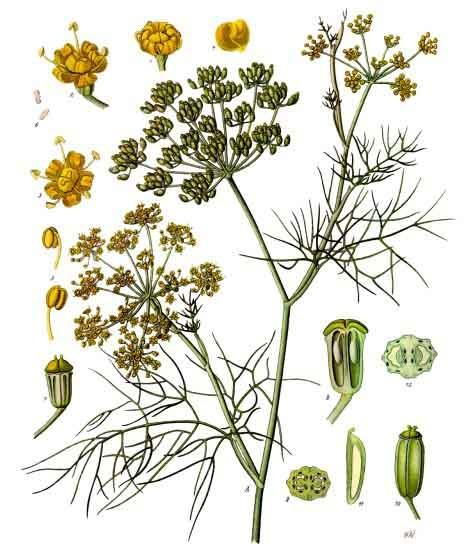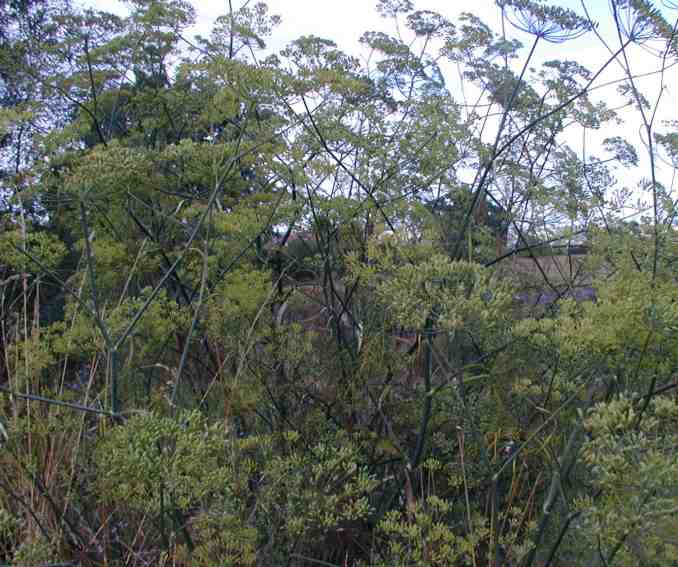
Foeniculum vulgare (Mill.)
Synonyms and Common names: Fenkel, Finkle, Fennel fruit, foeniculi
fructus
German = Fenchel, French = Fenouil, Spanish = Hinojo, Italian = Finocchio
Order: Umbelliferae
Description: Fennel is a short-lived perennial indigenous to Europe and cultivated in India, China and Egypt. It is a greyish-green, hairless plant with vertically-grooved, branched stems which smell of aniseed when crushed. The three- to four-pinnate dark green leaves have feathery lobes and the yellow flowers, appearing from July to September, occur in four to thirty simple umbels in a compound umbel. The fruits are ovoid-oblong and ridged. Fennel prefers to grow on bare ground in coastal areas.
Parts used: The fruit. The herb and fresh bulb can be cooked.
Collection: The seeds are harvested when ripe in autumn.
Constituents: up to 8% volatile oil (including about 80% antheole, up to 5% estragole, and fenchone), flavonoids (rutin, quercetin and kaempferol glycosides), coumarins (bergapten, imperatorin, xanthotoxin and marmesin), sterols, fixed oils and sugars.
Actions: stomachic, carminative, aromatic, orexigenic, anti-inflammatory, antimicrobial, diuretic, galactagogue
Indications: flatulent dyspepsia, anorexia, flatulent colic in children; topical eyewash for conjunctivitis and blepharitis; gargle for pharyngitis
Therapeutics and Pharmacology: Foeniculum is primarily used in the treatment of mild, spasmodic gastrointestinal complaints such as flatulence and colic in children, and indigestion, bloating and heartburn in adults. Both the seeds and the root are appetite stimulants and sooth the digestion. The volatile oil has both carminative and spasmolytic actions, and has been shown to increase liver regeneration experimentally.
 Foeniculum is a useful remedy for upper respiratory catarrh
and has a calming effect on bronchitis and coughs. It is also diuretic, and is
used to treat urinary calculi. The volatile oil is bactericidal and
anti-fungal, and has been shown to be effective in vitro against Staphylococcus
aureus and Candida albicans. It is also slightly oestrogenic, and is
a well-known means of promoting the flow of breast milk.
Foeniculum is a useful remedy for upper respiratory catarrh
and has a calming effect on bronchitis and coughs. It is also diuretic, and is
used to treat urinary calculi. The volatile oil is bactericidal and
anti-fungal, and has been shown to be effective in vitro against Staphylococcus
aureus and Candida albicans. It is also slightly oestrogenic, and is
a well-known means of promoting the flow of breast milk.
Externally, the oil relieves muscular and rheumatic pains, and the infusion may be used in a compress to treat conjunctivitis and blepharitis. The seeds have a traditional reputation as an aid to weight loss and longevity.
Combinations: Foeniculum can be combined with Chamaemelum, Acorus and Alpinia in flatulent colic; with Barosma and Arctostaphylos in bacterial cystitis; or with Rosmarinus, Salvia and Hamamelis as a gargle in inflammation of the mouth and throat.
Caution: No contraindications or interactions with other drugs are known. Diabetics should be aware of the sugar content of fennel syrup.
Preparation and Dosage: (thrice daily)
Regulatory Status: GSL Schedule 1
Dried fruits: 0.3-0.6g or as infusion
Liquid Extract: 1:1 in 70% alcohol, 0.8-2ml
Fennel Oil B.P.C. (1949) 0.03-0.2ml
Aq. Foenic. Conc. B.P.C. (1934) 0.3-1ml
Aq. Foenic. Dest. B.P.C. (1934) 15-30ml
Additional Comments: Fennel is used as a flavouring in drinks and sweets and has been used as a vegetable and medicine since ancient times. Pliny recommended Fennel for �dimness of vision�, while Gerard wrote �Fennel seede drunke assuageth the paine of the stomache, and the wambling of the same, or desire to vomite, and breaketh winde�. It was believed to have magical powers in the Middle Ages and was hung over doors to keep out witches. It was also considered to be a remedy for snakebite. In the past, the poor ate Fennel to satisfy hunger pangs on fast days and to make unsavoury food palatable. Fennel sprigs used to be placed in horses� harnesses to keep flies away. Chinese medicine prescribes fennel for food poisoning, hernias, abdominal pain and indigestion.
Bibliography
Bartram, T. 1995 Encyclopedia of Herbal Medicine, 1st edn.,Grace Publishers, Bournemouth.
Bremness, L. 1994 Herbs, Dorling Kindersley Eyewitness Handbook, London.
BHMA 1983 British Herbal Pharmacopoeia, BHMA, Bournemouth.
Chevallier, A. 1996 The Encyclopedia of Medicinal Plants, Dorling Kindersley, London.
ESCOP Monograph, 1996 Foeniculi fructus, European Scientific Committee on Phytotherapy
Gerard, J. 1633 The Herball or Generall Historie of Plantes, Facsimile Edition (1975), Dover Publications, New York.
Grieve, M. 1931 A Modern Herbal, (ed. C.F. Leyel 1985), London.
Grigson, G. 1996 (2nd.edn.) The Englishman�s Flora, Helicon Publishing, Oxford.
Hoffmann, D. 1990 The New Holistic Herbal, Second Edition, Element, Shaftesbury.
Hyperhealth 1996 Natural Health and Nutrition Databank, v.96.1 CD-ROM, �In-Tele-Health, available from Healthworks, Leeds. ISBN 0-646-30942-0
Lust, J. 1990 The Herb Book, Bantam, London.
Mabey, R. (ed.) 1991 The Complete New Herbal, Penguin, London.
Mills, S.Y. 1993 The Essential Book of Herbal Medicine, Penguin, London (First published in 1991 as Out of the Earth, Arkana)
Ody, P. 1993 The Herb Society's Complete Medicinal Herbal, Dorling Kindersley, London.
Polunin, M. and Robbins, C. 1992 The Natural Pharmacy, Dorling Kindersley, London.
Press, B. & Gibbons, B. 1993 Wild Flowers of Britain and Europe: Photographic Field Guide, New Holland Publishers, London.
Vickery, R. 1995 A Dictionary of Plant Lore, Oxford University Press.
Weiss, R.F. 1991 Herbal Medicine, Beaconsfield Arcanum, Beaconsfield.
Wren, R.C. 1988 Potter's New Cyclopaedia of Botanical Drugs and Preparations, C.W.Daniel, Saffron Walden.










